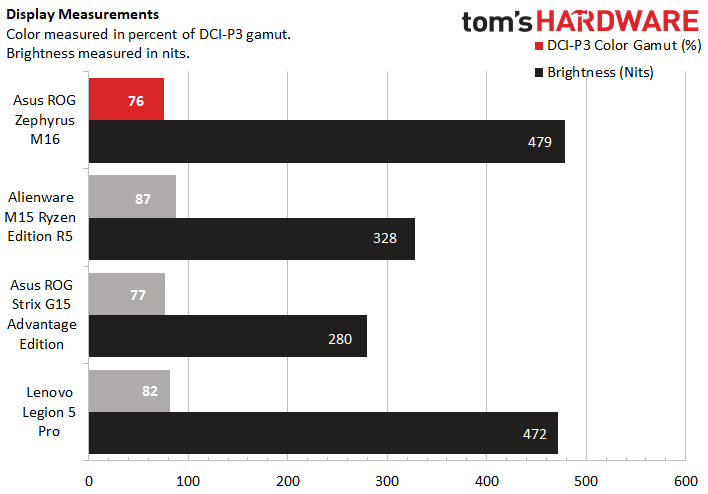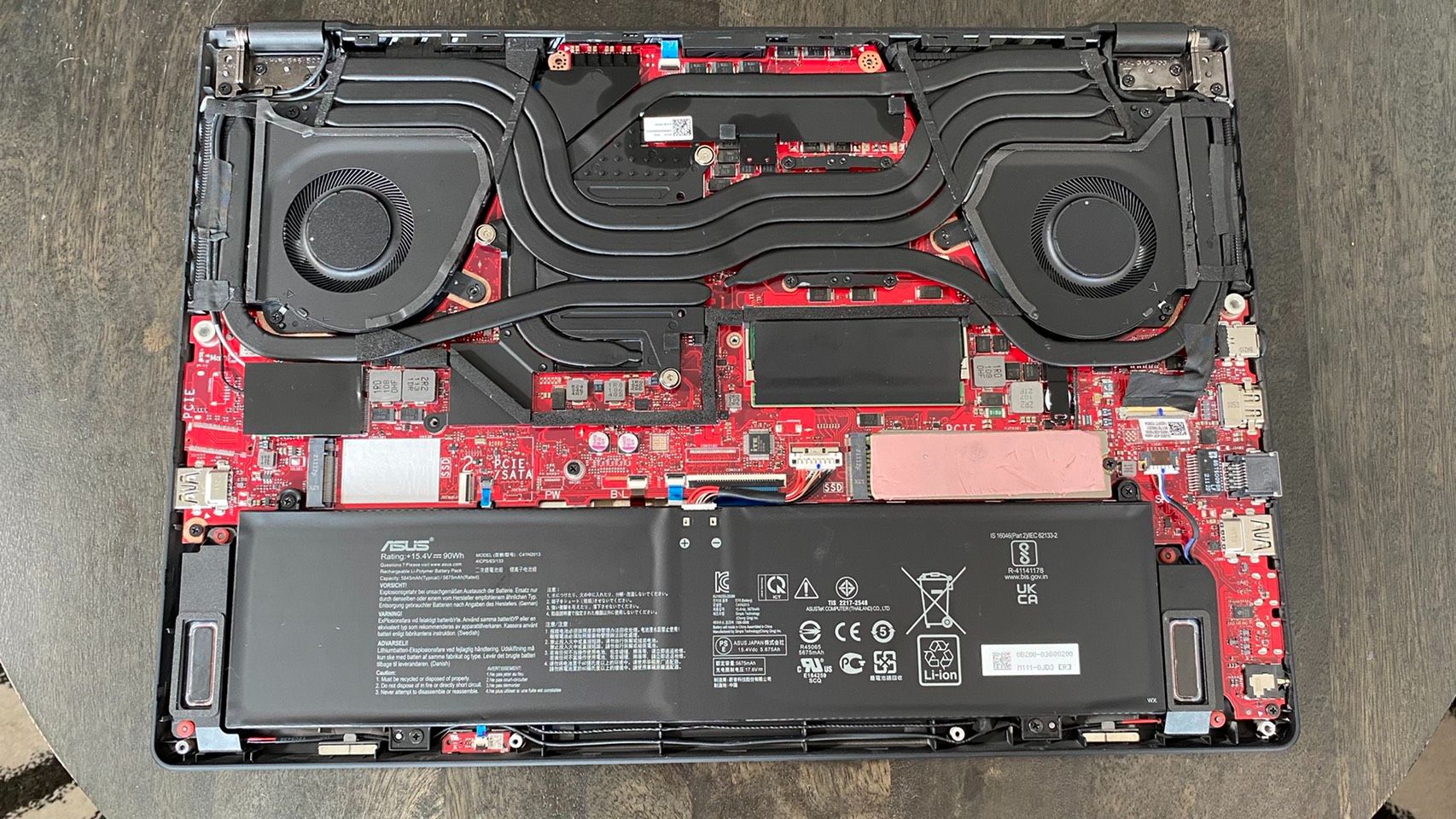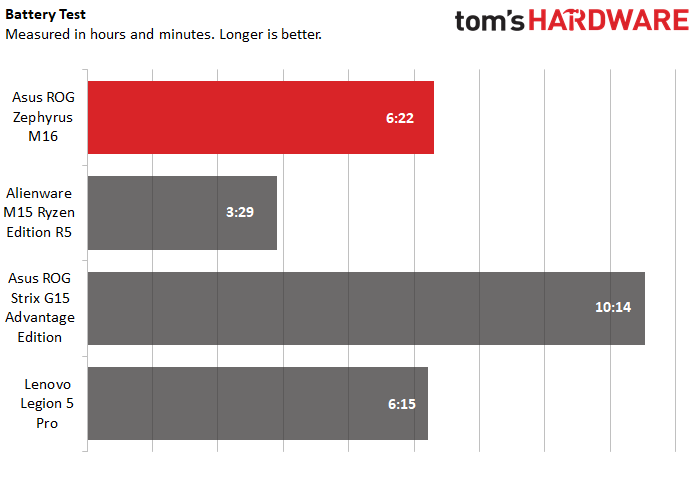Tom's Hardware Verdict
The Asus ROG Zephyrus M16 laptop aces its compact chassis and beautiful screen but has issues when it comes to power.
Pros
- +
Compact
- +
Bright
- +
2560 x 1600 resolution
- +
Clear audio
Cons
- -
Inconsistent gaming performance
- -
Pricey for what you get
Why you can trust Tom's Hardware
The Asus ROG Zephyrus M16 is Asus’ latest attempt to jump in on the 16:10 laptop display trend, and by that metric, it does an astounding job. Its screen is a large 16 inches diagonally, but the laptop’s chassis is otherwise built for a 15-inch model, which makes for extremely thin bezels and a thin, portable device. The bright screen’s 2560 x 1600 resolution is also beautiful to look at, but when it comes to performance, this laptop has problems with pricing and with living up to cheaper and similarly priced Ryzen competitors.
Despite having a high-power, 11th gen Intel Core i9 processor and an RTX 3060 laptop GPU in our configuration, this laptop was outperformed by rivals across about half of our game testing library. And that makes it a hard sell given that it’s pretty expensive, too.
Specifications
| CPU | Intel Core i9-11900H |
| Graphics | Nvidia RTX 3060 GDDR6 8GB with 1,426 MHz boost clock and 95W TGP |
| Memory | 16GB DDR4-3200 |
| Storage | 1TB M.2 NVMe SSD |
| Display | 16 inches, IPS, 2560 x 1600, 165Hz |
| Networking | 802.11ax Intel Wi-Fi 6, Bluetooth 5.1 |
| Ports | 1x Thunderbolt 4 |
| Row 7 - Cell 0 | 1x USB 3.2 Gen 2 Type-C |
| Row 8 - Cell 0 | 1x USB 3.2 Gen 2 Type-A |
| Row 9 - Cell 0 | 1x USB 3.2 Gen 1 Type-A |
| Row 10 - Cell 0 | 1x MicroSD reader |
| Row 11 - Cell 0 | 1x HDMI 2.0 |
| Row 12 - Cell 0 | 1x 3.5mm combination headphone/microphone jack |
| Row 13 - Cell 0 | 1x RJ-45 Ethernet Connector |
| Battery | 90 Whr |
| Power Adapter | 240 W |
| Operating System | Windows 10 Home |
| Dimensions (WxDxH) | 13.98 x 9.59 x 0.78 inches (355 x 243.5 x 19.9mm) |
| Weight | 4.19 pounds |
| Price (as configured) | $1,849 |
Design of Asus ROG Zephyrus M16
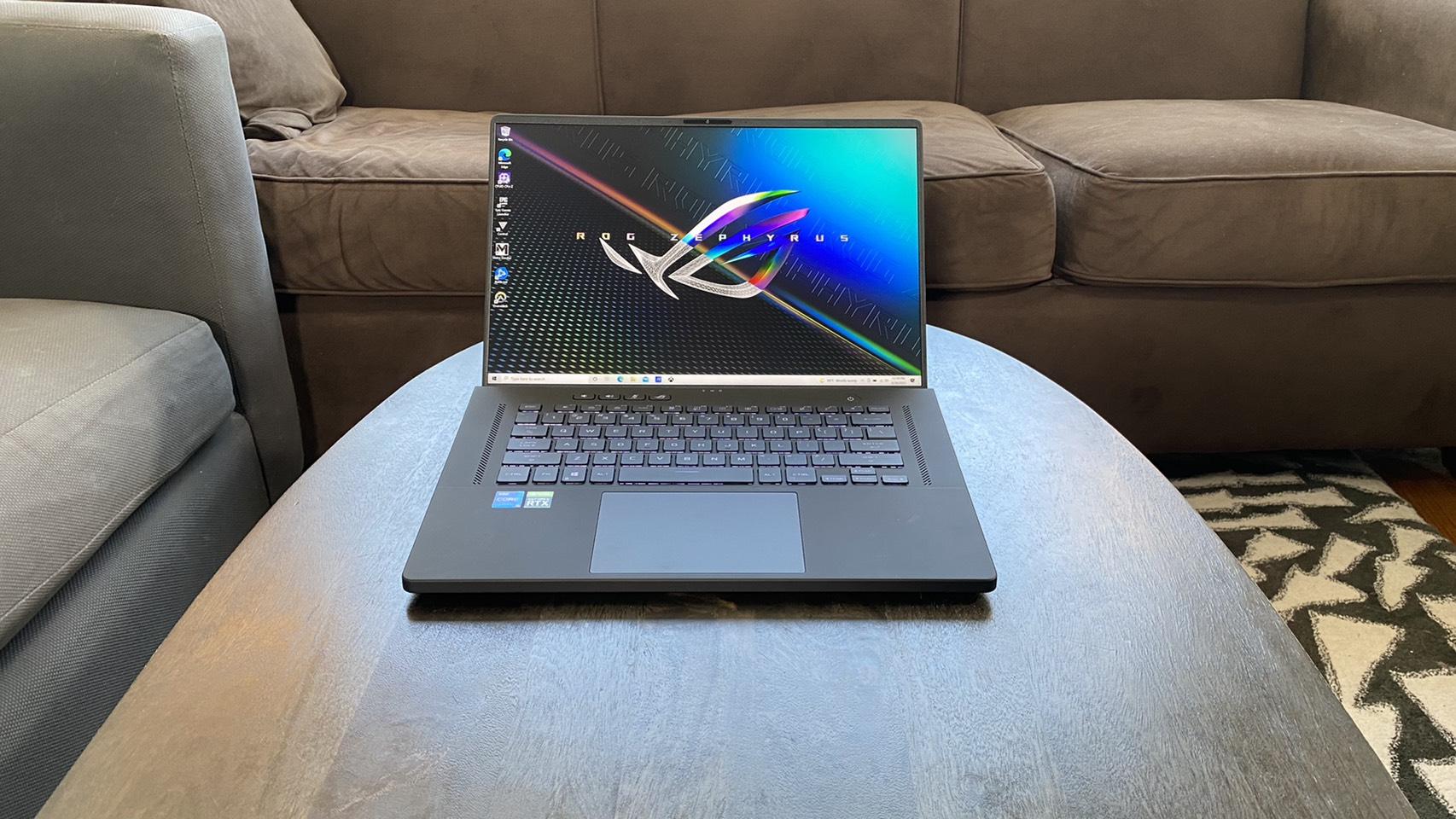
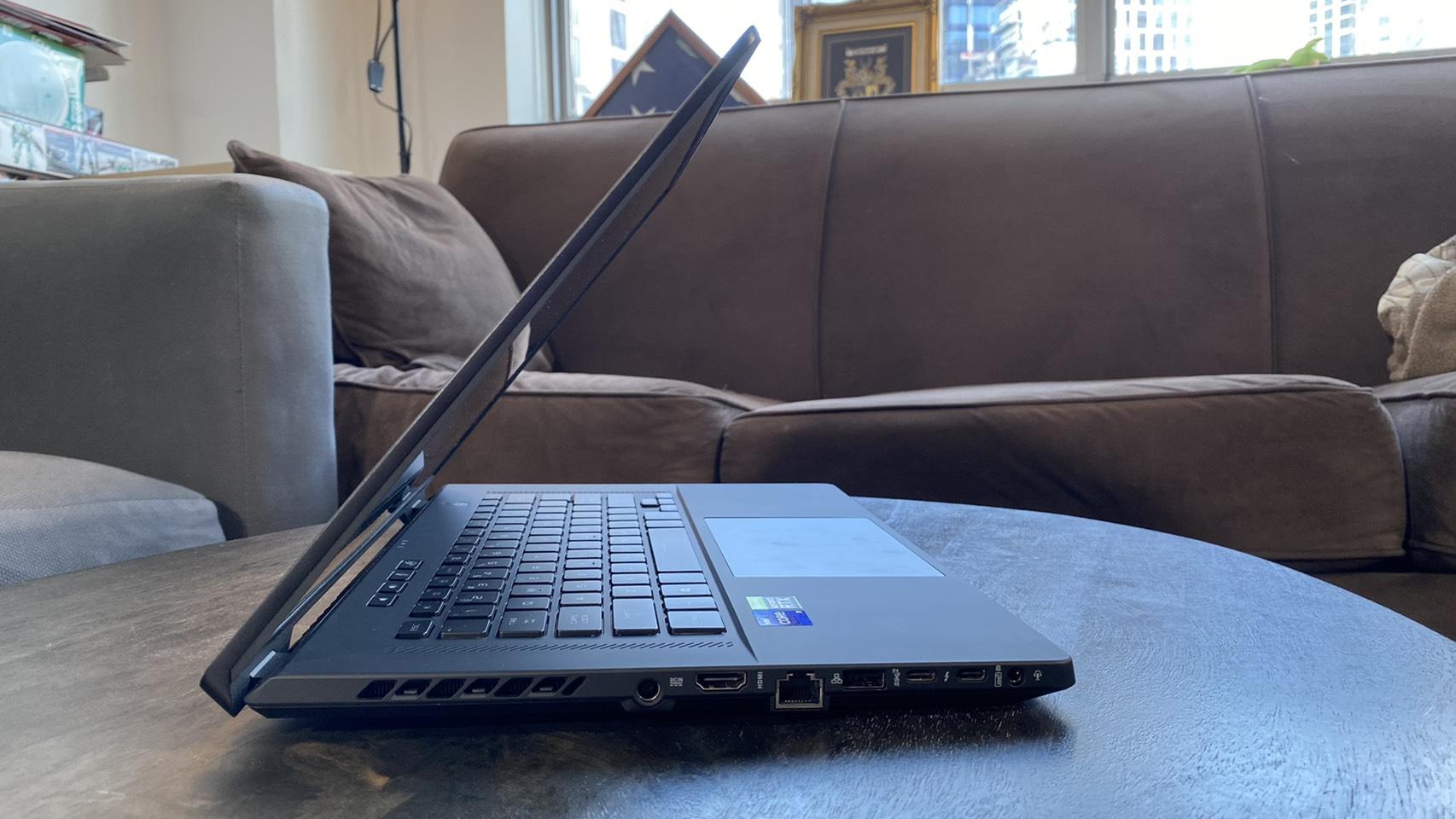
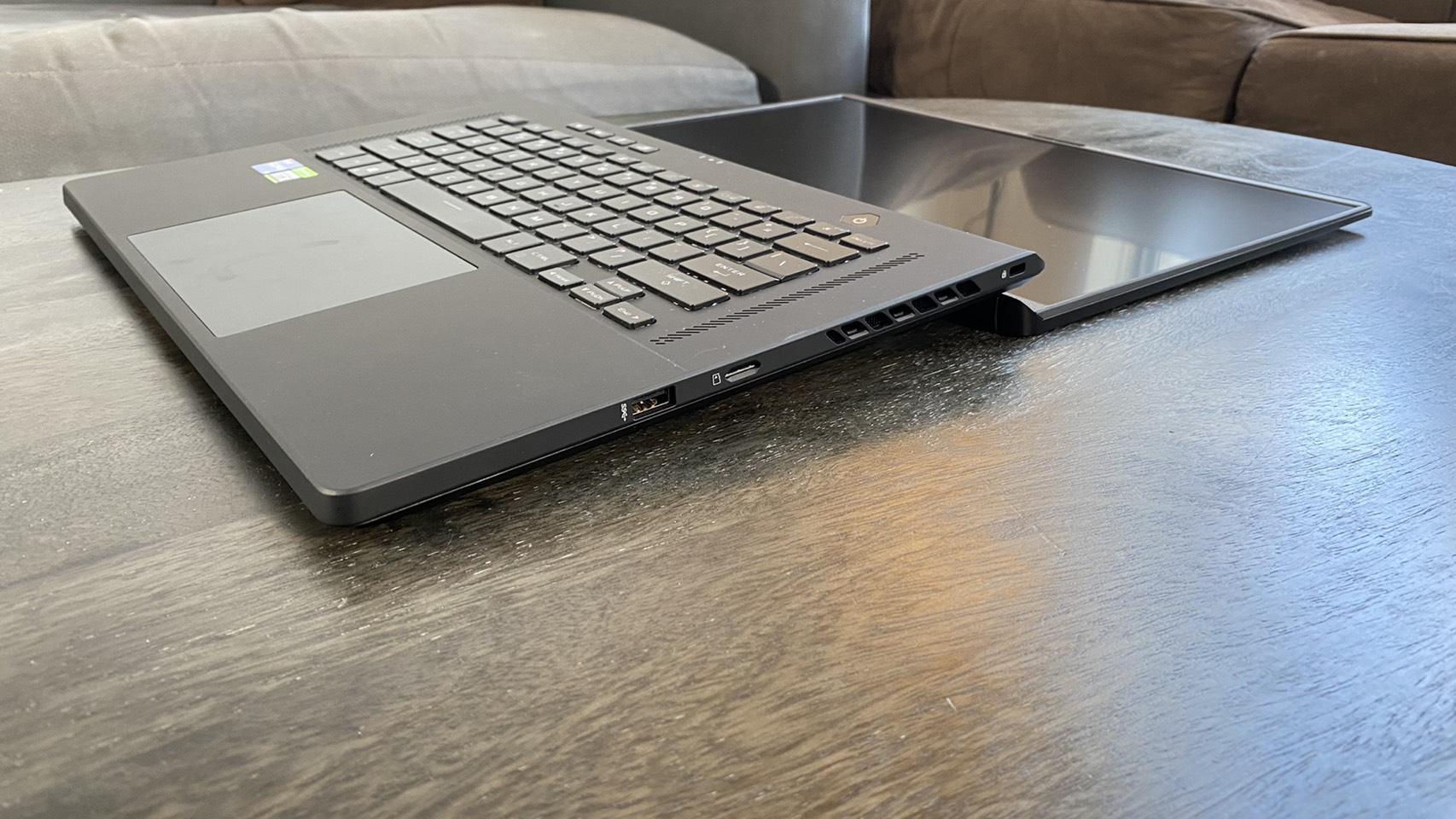
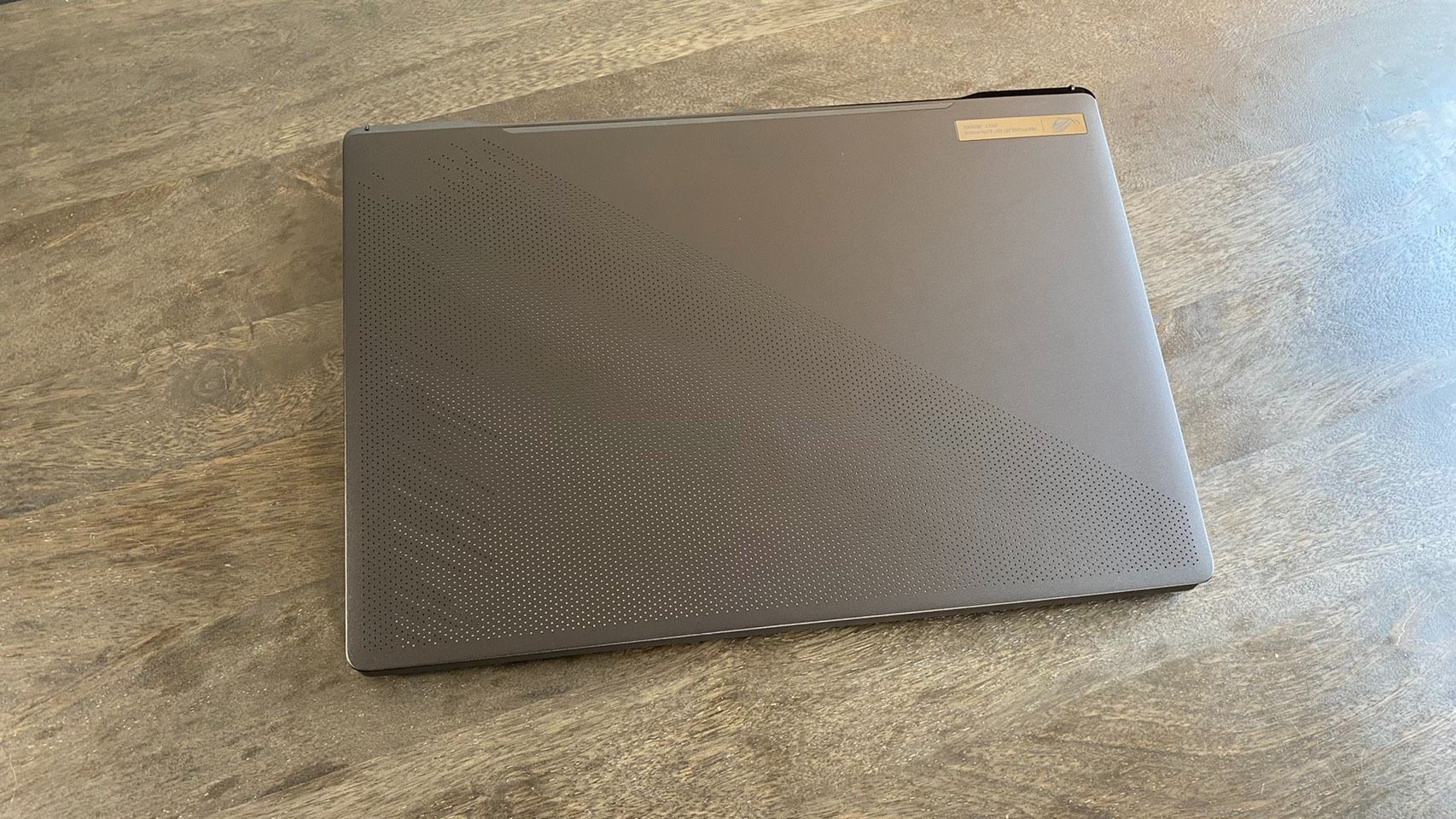
According to Asus, the ROG Zephyrus M16 offers a 94% screen-to-body ratio with thin bezels and a 16-inch display built into a 15-inch chassis. That gives it slightly more screen space than other, similarly-sized laptops, which tend to opt for 15.6-inch screens. But it’s also still got plenty of ROG-style gamer design work on it, which can look a little cramped on this smaller chassis.
Most of this laptop’s lid is taken up by a diagonal pattern of dots that conceal a silver wave-like pattern that you can only see when looking at them from certain angles. Its sides have large and noticeable vents and also feature the I/O. There’s also LEDs across the back vents to indicate system status. The system’s back vents are also visible from the inside of the laptop, which also has a minor inlet that the keyboard sits inside of, plus top-firing speakers on either side. A bumper on the monitor also lifts the keyboard diagonally up off your desk when you open the lid.
That’s a lot of decoration, and it does run the risk of being gaudy. But this is also a laptop that, by default, flashes its keyboard’s lights every few seconds when asleep. It knows what it’s about, and if you dig that gamer aesthetic, all that extra detailing might appeal to you.
What’s appealing no matter what is the size of this thing. At 13.98 x 9.59 x 0.78 inches large, it’s smaller and much thinner than every similarly specced competitor we tested. The Alienware M15 Ryzen Edition R5, for instance, is 14.02 x 10.73 x 0.9 inches, while the Lenovo Legion 5 Pro is 14.02 x 10.41 x 1.07 inches. The Asus ROG Strix G15 Advantage Edition is a little less long than the Zephyrus M16, measuring 13.94 x 10.2 x 1.07 inches, but it’s bulkier everywhere else.
This is also a small laptop, weighing just 4.19 pounds. That’s easily lighter than the Alienware’s 5.34 pounds and the Legion’s 5.4 pounds. Plus, the ROG Strix G15 Advantage Edition is a hefty 6.61 pounds, which makes the Zephyrus M16 look even more lightweight.
Get Tom's Hardware's best news and in-depth reviews, straight to your inbox.
This laptop also has a wide variety of ports, although most are relegated to the laptop’s left side. To start, the left side has the charging port, an HDMI 2.0 connector and an RJ-45 ethernet port that looks a little bulky here. It’s also got a USB 3.2 Gen 2 Type-A port, a 3.5mm headphone/microphone jack, a Thunderbolt 4 charging-capable port and a USB 3.2 Gen 2 Type-C connection that can also handle DisplayPort. By contrast, the laptop’s right side has a single USB 3.2 Gen 1 Type-A USB port and a microSD card reader.
Gaming Performance of Asus ROG Zephyrus M16
The ROG Zephyrus M16 comes equipped with both an Intel Core i9-11900H high power CPU and an RTX 3060 laptop GPU with 8GB of GDDR6 VRAM, a 1,426 MHz boost clock and a 95W TGP. That leaves it in somewhat of a specs middle ground for RTX 3000 series laptops, as it’s got a high-end CPU but a mid-range Ampere GPU.


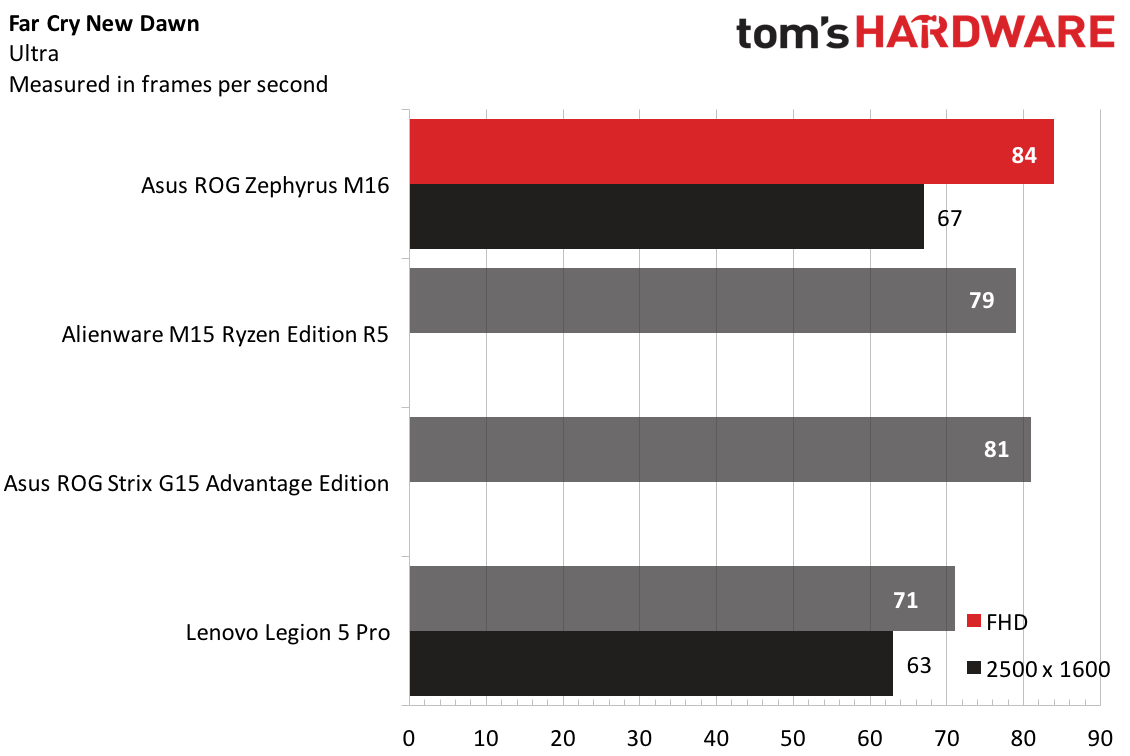
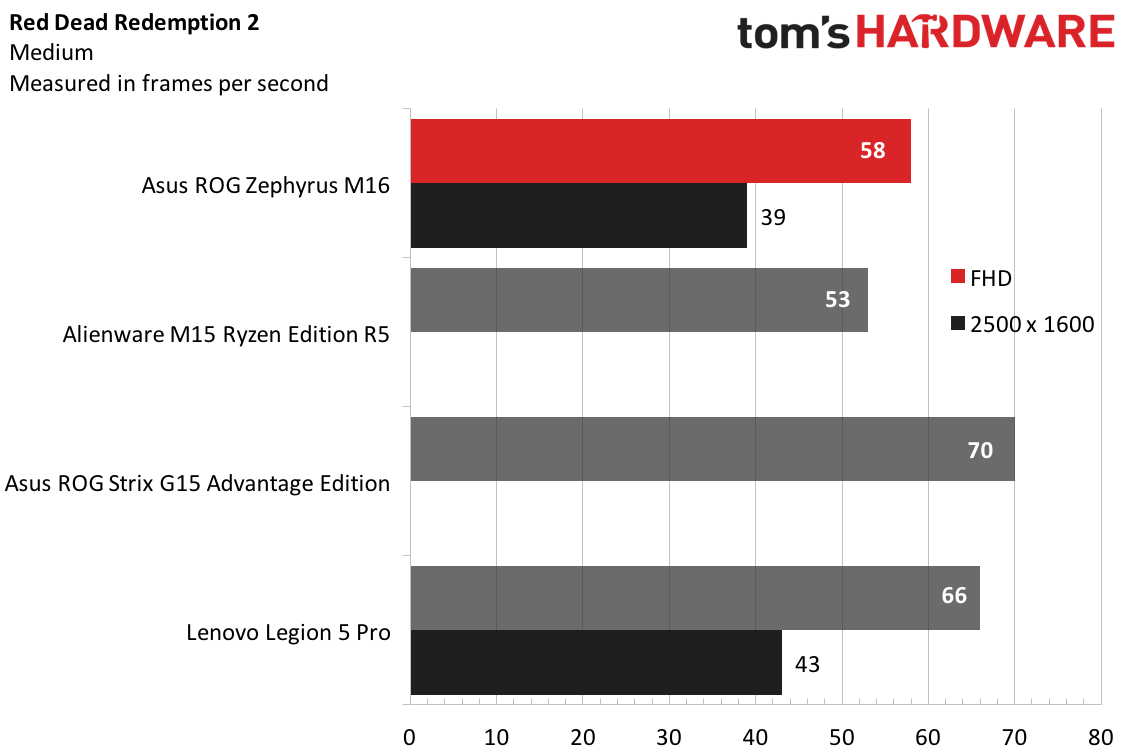
For instance, in Shadow of the Tomb Raider, the Zephyrus M16 only achieved 69 fps in the game’s pre-built benchmark running in FHD at its highest settings. By contrast, the Alienware M15 Ryzen Edition R5 (Ryzen 7 5800H/RTX 3060) hit 73 fps, and it only gets higher from there. The Lenovo Legion 5 Pro (Ryzen 7 5800H/RTX 3070) hit 80 fps thanks to its higher-end graphics card, and the Asus ROG Strix G15 Advantage Edition (Ryzen 9 5900HX/Radeon RX 6800M) jumped all the way up to 88 fps.
The Zephyrus M16 also ran a little slow in Red Dead Redemption 2’s benchmark running in FHD at medium settings, though it wasn’t our lowest performer. At 58 fps, it just edged out the Alienware M15 Ryzen Edition R5’s 53 fps. Still, the Legion 5 Pro edged it out with 66 fps and the ROG Strix crushed it with 70 fps.
Grand Theft Auto V’s benchmark running at FHD with very high settings saw the Zephyrus M16 running at 86 fps. That’s ahead of the Alienware’s 82 fps and the Legion’s 84 fps, if barely. The ROG Strix still took the lead here, with 98 fps.
Finally, Far Cry: New Dawn is where the Zephyrus M16 actually came out on top. Here, it ran at 84 fps. Meanwhile, the Legion only hit 71 fps, the Alienware pushed up to 79 fps and the ROG Strix barely trailed behind at 81 fps.
Essentially, performance was inconsistent, but typically the Zephyrus' Intel processor was beaten by Ryzen competitors, even with similar GPUs.
We also ran the Metro: Exodus RTX benchmark 15 times in a row on the Zephyrus M16 to simulate an extended gaming session. Here, the laptop ran at an average 53.51 fps. The CPU clock speed averaged 4.35 GHz while the GPU clock speed averaged 1.40 GHz. The CPU’s temperature was an average of 72.82 degrees Celsius during this test, and the GPU’s temperature was an average 73.98 degrees Celsius.
For a more personal touch, I also played Control on the Zephyrus M16 for a half hour to see how it handles during actual gameplay. Here, I was able to test both FHD gameplay as well as how well the PC holds up at its maximum 2560 x 1600 resolution. Unfortunately, I wasn’t too impressed. At high presets, the game ran between 27 - 33 fps at 2560 x 1600 resolution, and turning ray tracing on to its high preset reduced that to a slideshow-like 13 - 17 fps. FHD performance was more within my expectations, topping out at 62 fps with ray tracing off and 42 fps with it on. On the plus side, heat was imperceptible through the laptop’s case, and the fan only occasionally got noisy, usually during moments of heavy action and only for a few seconds at a time. Granted, this laptop uses an RTX 3060 and this is a more punishing game, but to both get 60 fps and get the most out of that high resolution display, you’re going to need to adjust your settings down to low presets without ray tracing on. Luckily, while this laptop can’t push 2560 x 1600 medium settings at a consistent 60 fps, the low preset does hit between 70 - 80 fps, so you might also be able to get away with a custom configuration that combines medium and low options.
Productivity Performance of Asus ROG Zephyrus M16
The Asus ROG Zephyrus M16’s Intel Core i9-11900H chip gives it exceptional prowess as a productivity machine, although its SSD ran towards the slower end in our tests.
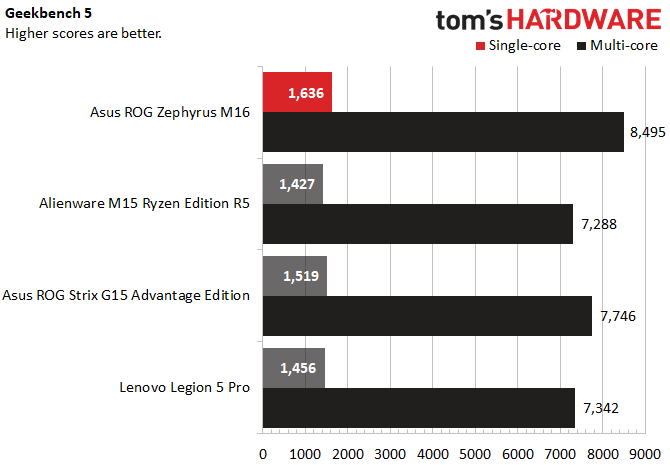
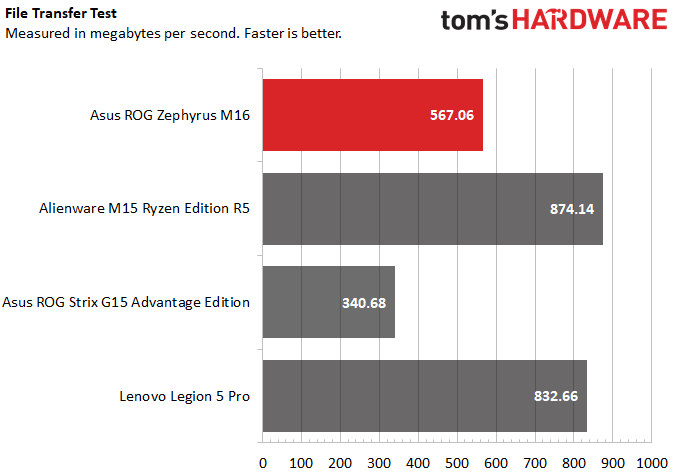
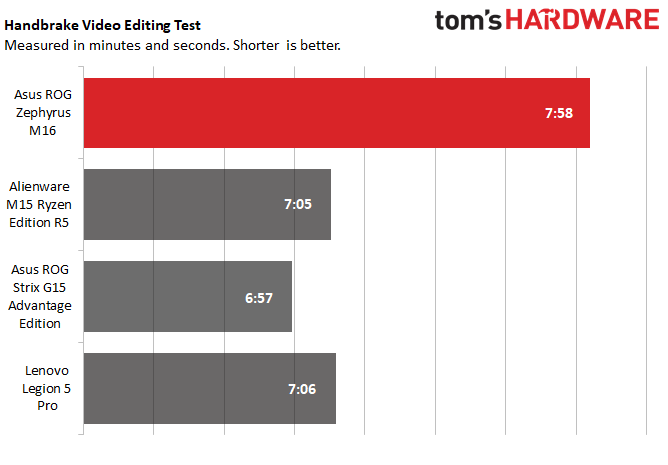
In Geekbench 5, which synthetically benchmarks general PC performance, the Zephyrus M16 scored 1,646 points on single-core tests and 8,495 points on multi-core tests. That’s slightly ahead of all of its competitors. The Alienware M15 Ryzen Edition R5 (Ryzen 7 5800H) topped out at scores of 1,427/7,288, while the Lenovo Legion 5 Pro (Ryzen 7 5800H) was only slightly ahead of it with scores of 1,456/7,342. The Asus ROG Strix G15 Advantage Edition (Ryzen 9 5900HX) came closest to the Zephyrus M16’s numbers, hitting scores of 1,519/7,746.
Our file transfer speed benchmark, where we track how quickly a computer can move 25GB of files, is where the Zephyrus M16 started to slow down, although it wasn’t the most sluggish competitor. It transferred files at a rate of 567.06 MBps, which is much slower than the 832.66 MBps we saw on the Legion and the 874.14 MBps we saw on the Alienware. The ROG Strix was the slowest laptop of this bunch, hitting just 340.68 MBps.
The Zephyrus M16 was also slower than competitors in our Handbrake benchmark, where we track how quickly a computer can transcode a video down from 4K to FHD, though not by much. Here, it completed the task in 7:58, while the Alienware did so in 7:05 and the Legion in 7:06. The ROG Strix was the fastest here, and finished transcoding in 6:57.
Display of Asus ROG Zephyrus M16

The Zephyrus M16 is yet another entrant into the 16:10 laptop club, and gives it a gaming edge with a 2560 x 1600 @ 165Hz IPS panel. I’m a big fan of both this aspect ratio and QHD resolutions on laptops, and this screen was a great reminder of what I like about both.
To test viewing content on the Zephyrus M16, I watched the trailer for The Conjuring: The Devil Made Me Do it. Here, I found that colors were mildly vivid but that blacks were extremely deep (a must-have for a horror movie). I could see the screen clearly from almost any viewing angle, and I only encountered minor glare when I had the laptop perpendicular to my office window. Drawing my curtain and turning my lights off eliminated that glare entirely, although the screen was so bright regardless that I didn’t feel this was a necessity.
The 16:10 aspect ratio also gave me extra vertical space on my screen, which was convenient for scrolling through webpages to either research articles or even write this review.
Meanwhile, the 165 Hz screen meant I was able to see every one of the about 135 -155 fps I was hitting in Overwatch on high settings at 2560 x 1600. Since I couldn’t hit 165Hz on this five year-old title without making some major graphics compromises, 165 Hz might actually have been overkill— a 144 Hz screen might have been more economical. But it should work better with even older titles like Team Fortress 2 or Counter-Strike: Global Offensive. Or, if frame rate is always your top priority, you can always play at low settings or even a lower resolution.
Our color and brightness testing coincided with my anecdotal experience. The ROG Zephyrus M16 covered 75.8% of the DCI-P3 spectrum according to our colorimeter. That’s a respectable score, even if the laptop’s competitors beat it. The Alienware M15 Ryzen Edition R5 covered 87.3 percent of the DCI-P3 spectrum, while the Lenovo Legion 5 Pro had a more muted lead at 82%. The Asus ROG Strix G15 Advantage Edition had the closest numbers to the Zephyrus M16, with 76.7% DCI-P3 coverage.
As for brightness, the Zephyrus M16’s recorded 479 nits average only faced major competition from one other laptop: the Legion 5 Pro, which hit 472 nits. Meanwhile, the Alienware had an average 328 nits brightness and the ROG Strix took that number down to 280 nits.
Keyboard and Touchpad on Asus ROG Zephyrus M16
The ROG Zephyrus M16 has a tenkeyless keyboard with 1-zone RGB lighting. Most keys are full-sized, but the arrow keys are half-sized. The keyboard is also raised at an angle when you open the laptop’s lid, to make for a comfortable diagonal typing surface. There’s also dedicated media keys for volume and mic input that sit just above the keyboard, plus a programmable key that, by default, opens the Asus Armoury Crate app.
This laptop’s keycaps use a chiclet style with no detailing aside from on the W, F and J keys, which leads to flat surfaces that can feel slippery from time to time. Keypresses do feel cushiony on completion, though, and I was able to hit between 75 - 79 words per minute on most of the 10fastfingers.com typing tests I took with this keyboard. Asus did not provide travel distance numbers, but key travel did feel generous, which made physical feedback more noticeable and typing by touch alone easie
The 5.1 x 3.4-inch precision touchpad is, for the most part, a joy to use. Its massive size and smooth surface make for easy scrolling, but it still has enough friction to make precise movements easy to input. Multi-touch gestures like three-finger app switching and two-finger scrolling work especially well, with none of the resistance or physical discomfort I tend to encounter on most other touchpads. The power button also doubles as this laptop’s fingerprint reader, so the touchpad doesn’t need to have a dead zone to make way for one.
My only problem with the touchpad was that its palm rejection could sometimes fail, as the touchpad would occasionally implement a tap-click or even a swipe if I wasn’t careful about my palm placement. Luckily, you can turn off touchpad input via a shortcut on the funcion row for gaming sessions with an external mouse.
Audio on Asus ROG Zephyrus M16
The Asus ROG Zephyrus M16 has two bottom firing and two top firing speakers that make for a quiet but high fidelity listening experience.
I tested this laptop’s speakers by listening to Butter by BTS, where I was impressed by how little the vocals and highs changed from when I was listening to the song on headphones. The bass had a little less impact, but didn’t lose any information, and I was easily able to distinguish between details like drum hits and cymbal beats.
The speakers were on the quiet end, though, with a comfortable listening volume at around 70% - 75%. I was easily able to hear the song across my home office, but not as well outside of the room. This shouldn’t be too much of an issue for most people, but if you’re hard of hearing, it might be difficult to make out dialogue scenes in film on this laptop. That said, changing to the “Voice” and “Movie” audio settings in the laptop’s included Dolby Access app can help with this just a little bit.
Upgradeability of the Asus ROG Zephyrus M16
Taking the bottom case off the Asus ROG Zephyrus M16 is a bit of an ordeal. First, use a Phillip’s head screwdriver (I used a P00 bit) to remove 9 of the laptop’s outer screws and loosen the pop-up screw that’s in what is the lower-right corner if you have the case’s label facing upwards. Then, use a flathead screwdriver and some force to twist off the rubber caps that cover the case’s three center screws. Don’t worry— I was able to get these back on afterwards. Finally, just remove the three center screws with your Phillip’s head screwdriver and pry off the case.
Once inside, you’ll see an admittedly cool red motherboard, the networking chip, an open M.2 SSD slot, an M.2 SSD slot that’s already in use and an 8GB DIMM of RAM. Since this system has 16GB of RAM, we’re guessing the rest is soldered in.
Asus ROG Zephyrus M16 Webcam
Despite having such thin bezels, the ROG Zephyrus M16 has still managed to fit a 720p webcam into its upper bezel. This is a big deal, because Asus had removed webcams from most of its laptops for the past few years with the expectation that gamers would bring their own if they wanted one. The last 18 months, however, have proven having one is necessary.
Unfortunately, while this webcam's color is accurate if you have enough light, it leaves shots with plenty of artifacts regardless of lighting. It also had a tendency to make me look undead in dim light and like a tangerine in heavy light.



Asus ROG Zephyrus M16 Battery Life
The Asus ROG Zephyrus M16 is long-lasting when it comes to gaming laptop battery life. In our non-gaming battery life test, which continually streams video, browses the web and runs OpenGL tests at 150 nits of brightness, it held on for 6 hour and 22 minutes before turning off. That’s just slightly above the Lenovo Legion 5 Pro’s 6:15 hours of battery life and well over the 3:29 hours of battery life offered by the Alienware M15 Ryzen Edition R5.
The Asus ROG Strix G15 Advantage Edition did drastically outlast the Zephyrus M16 with a battery life of 10:14 hours, although battery lives that long are a rarity among gaming laptops.
Asus ROG Zephyrus M16 Heat
Although I never felt the heat through the chassis, the ROG Zephyrus M16 can get toasty under even light load. After 15 minutes of streaming video, its touchpad was a nominal 85.5 degrees Fahrenheit, but every other measurement we took was over 100 degrees. The center of the keyboard (between the G and H keys) was 104.5 degrees Fahrenheit, while the underside was 114.5 degrees Fahrenheit.
While 114.5 is the hottest the laptop got under non-gaming loads, it got even warmer when we took its temperature during its sixth consecutive run of the Metro: Exodus Ultra benchmark. Here, the touchpad registered a cooler 84.5 degrees Fahrenheit, but the center of the keyboard hit 108.5 degrees Fahrenheit and the underside was generally 125 degrees Fahrenheit. The underside did have a hotspot opposite the keyboard’s 7 key, though, where it hit 135 degrees Fahrenheit.
Asus ROG Zephyrus M16 Software and Warranty
Asus generally does a great job of not installing bloatware on its gaming laptops, and that’s no different here. Aside from Windows pack-ins like Microsoft Solitaire Collection, Intel inclusions like its Driver and Support Assistant, and Dolby Access for adjusting audio and video settings, there’s only two apps from Asus itself.
The first of these apps is Armoury Crate, where you’ll adjust lighting, view performance metrics, change your programmable keyboard button and the like. There’s also Aura Creator, where you can make custom RGB lighting effects to use with the keyboard.
Configurations for Asus ROG Zephyrus M16
The Asus ROG Zephyrus M16 has four configurations listed on its website, though we could only find two of those configurations in store for now. Our unit was included among these, and costs a whopping $1,849. For that price, you’ll get an Intel Core i9-11900H CPU, an RTX 3060 laptop GPU, 16GB of DDR4-3200 memory and a 1TB SSD. It also has that gorgeous 16 inch, 16:10, 2560 x 1600 display, which all configurations of this laptop share.
Meanwhile, the cheapest configuration actually up for sale at the moment is a $1,449 model with a Core i7-11800H processor, an RTX 3050 Ti, 16GB of RAM and a 512GB SSD. Best Buy’s current listing accidentally calls the GPU an RTX 3060 Ti in several places, but an Asus representative confirmed to us that these were typos.
Asus has not told us when the other configurations listed on its website would become available.
Bottom Line
The ROG Zephyrus M16 offers a lot to like thanks to a small build and a genuinely excellent 2560 x 1600 screen, but its steep $1,849 price point and mixed performance across our game library makes it difficult to pick over competing models, especially since it’s not the only laptop we tested that has a great display at that resolution.
If power is your primary goal, the Alienware M15 Ryzen Edition R5 either beat or performed similarly to the Zephyrus M16 in most of our gaming tests, and costs $200 less. Meanwhile, the similarly priced Lenovo Legion 5 Pro outperformed the Zephyrus M16 in half of our tests (though mildly lost out in others) and also has its own gorgeous 2560 x 1600 display.
Also, while the Zephyrus M16 has a great screen, it’s only got a so-so keyboard. It’s a decent choice if you must go with Intel, but even among Asus computers, there are compelling and more powerful Ryzen-based alternatives like the Asus ROG Strix G15 Advantage Edition.
The small chassis does offer the Zephyrus M16 a unique selling point, but that’s about the only place where it definitely beats the competition.
Michelle Ehrhardt is an editor at Tom's Hardware. She's been following tech since her family got a Gateway running Windows 95, and is now on her third custom-built system. Her work has been published in publications like Paste, The Atlantic, and Kill Screen, just to name a few. She also holds a master's degree in game design from NYU.
-
ConfusedCounsel Wow the Ryzen 5900HS, 3070, 165Hz QHD version costs the same and performs way better. ASUS ROG Zephyrus 15.6" QHD Gaming Laptop AMD Ryzen 9 16GB Memory NVIDIA GeForce RTX 3070 1TB SSD Eclipse Grey Eclipse Grey GA503QR-211.ZG15 - Best Buy My daughter got one for her Mother for Mother's Day. Laptop Media reports nearly full DCI-P3 Coverage. ASUS ROG Zephyrus G15 GA503 review – rises from the ashes with a QHD 165Hz display and beast hardware (laptopmedia.com) It also performs better on games. I have seen 88 FPS on Shadow of the Tomb Raider (highest settings). So, I am surprised the intel variant costs more for way less performance; probably due to the step down to a 3060. Ms. Ehrhardt, if you get a chance, you should really write an articles comparing all the Zephyrus models. Amazing how a processor or a few watts can make a big performance on the same platform.Reply -
blapbooo ........... you do realize that you have to use the external displayport to benchmark right? The nvidia optimus stuff tanks the framerate and spikes the CPU usage when using the laptop displayReply
